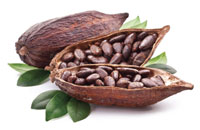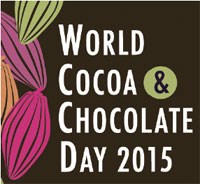

“The World Index of commodity prices (at October 2015) reports an average price for cocoa beans of US$3160.24 per metric tonne. Premium beans in Trinidad have been known to fetch over US$7000 per tonne; and the conservative international base price for Trinidad’s beans is US$5000.”
By Pat Ganase
Cocoa and chocolate can help diversify the Trinidad and Tobago economy away from non-renewable “black gold” to sustainable industries that integrate culture, people and the environment. A look at the cocoa value chain provides insight into the prospects behind our country’s “dark gold.”
Ten years ago, none of these brands were on the market. Enter the World Cocoa and Chocolate Day 2015, and there is a crush for space. Present are chocolate makers representing cocoa grown on estates around Trinidad: Cocobel from Rancho Quemado; Exotic Caribbean Mountain Pride from Tamana; Ortinola from Maracas St Joseph; Olando out of Tableland and Tobago; Tory Ven from Lopinot; JB Chocolates from Gran Couva; House of Arendel; Gina’s Fine Chocolates; Persad’s with beans from Montserrat Co-operative; and CRC’s Spirit of Chocolate, using beans from the International Genebank, Trinidad.
It is noticeable that these chocolate makers are cultivating not just the taste for locally grown and produced chocolate, but a taste for dark chocolate. “Dark” means higher percentages of cocoa solids, less sugar, focus on releasing the flavours of beans grown on single estates, proud of the “terroir” of the beans, that elusive sensory quality imbued by sunlight and soil.
Dr Darin Sukha of the Cocoa Research Centre, UWI, believes that this quality gives Trinidad and Tobago the edge as a premium cocoa and chocolate producer.
“Our cocoa should be treated in an analogous way to that of champagne, low volumes, high quality, high price, high profit and having a growing global demand. The country’s reputation for this premium crop has been cemented through its success at the International Cocoa Awards and the premium price it fetches on the market.
The World Index of commodity prices (at October 2015) reports an average price for cocoa beans of US$3160.24 per metric tonne. Premium beans in Trinidad have been known to fetch over US$7000 per tonne; and the conservative international base price for Trinidad’s beans is US$5000. Further, it is estimated that a tonne of cocoa beans may yield over a tonne – and as much as 1600 kg – of dark chocolate.
What is dark chocolate worth? The prices at the Chocolate Day 2015 are still “introductory prices” direct from producer to consumer. The TT$60 bar of 50gm Spirit of Chocolate is low by international standards. But consider this, our good fortune is the affordability of a completely locally grown, processed and packaged product! And the conversion of a metric tonne (1000 kg) of cocoa beans has the potential to gross almost TT$2 million at these local prices.
Here’s the enterprise in economic terms, simple and rounded but presented for consideration by shrewd businessmen interested in the development of Trinidad and Tobago. An estate of say 500 high-yielding cocoa trees may produce a tonne of beans a year. A tonne of beans may produce almost two tonnes of chocolate.
Chocolate production is also people intensive, with specialty skills required in every part of the process. Modern estate production is facilitated by the development of new productive clones of Trinitario – the cocoa variety that put Trinidad on the map around the cocoa-growing world. Mechanisation for processing cocoa beans is available. In the chocolate-making shop, skills training, research and continuous experimentation are encouraged. Innovation and development of new cocoa products are encouraged: candles, soaps, beauty products, teas, and of course, confectionery.
Landowners of old estates are sitting on a fortune. The older cocoa trees are still to be valued for flavour and as gene material. Revitalise with new high yielding stock. Take advantage of the resources that have been cultivated here for over a hundred years, with intellectual capital vested in the Cocoa Research Centre at UWI; estate skills and monitoring services at the Ministry of Agriculture; and shared experimentation in a new community of cocoa growers and artisan chocolate makers. What are we waiting for?
THE NOBLE BEAN
 The Cocoa Research Centre (CRC) located at The UWI St. Augustine grew out of the Imperial College of Tropical Agriculture (ICTA) and is regarded as the research and science centre for cocoa growers and chocolate producers around the world. (http://sta.uwi.edu/cru/) The Cocoa Research Centre (CRC) located at The UWI St. Augustine grew out of the Imperial College of Tropical Agriculture (ICTA) and is regarded as the research and science centre for cocoa growers and chocolate producers around the world. (http://sta.uwi.edu/cru/)
The newly established Cocoa Development Company is intended to extend the services of the Centre to produce innovations along the entire cocoa value chain. Investors with an eye on future returns from the world cocoa economy – now worth some US$83 billion – are invited to bank on cocoa business. Trinidad and Tobago is poised to turn the noble bean, food of the gods, Theobroma cacao L., into gold.
CHOCOLATE DAY
 World Cocoa and Chocolate Day 2015 allowed the Trinidad public, including school children, to meet chocolate makers and to sample their products. The event in the JFK Auditorium at The UWI featured some of the finest chocolate being made in Trinidad and Tobago, which is to say, among the finest in the world. The World Cocoa and Chocolate Day is the brainchild of the International Cocoa Organisation and the Académie Française du Chocolat et de la Confiserie to bring awareness of the living conditions of cocoa growers’ worldwide in an effort to build a sustainable cocoa economy. It is celebrated on October 1, every year since 2011. In Trinidad, the celebration is coordinated by the Cocoa Research Centre (CRC) at The UWI St Augustine, and supported by the Cocoa Development Company of Trinidad and Tobago, the Ministry of Agriculture, the Tourism Development Company, InvestTT, The UWI and University of Trinidad and Tobago. World Cocoa and Chocolate Day 2015 allowed the Trinidad public, including school children, to meet chocolate makers and to sample their products. The event in the JFK Auditorium at The UWI featured some of the finest chocolate being made in Trinidad and Tobago, which is to say, among the finest in the world. The World Cocoa and Chocolate Day is the brainchild of the International Cocoa Organisation and the Académie Française du Chocolat et de la Confiserie to bring awareness of the living conditions of cocoa growers’ worldwide in an effort to build a sustainable cocoa economy. It is celebrated on October 1, every year since 2011. In Trinidad, the celebration is coordinated by the Cocoa Research Centre (CRC) at The UWI St Augustine, and supported by the Cocoa Development Company of Trinidad and Tobago, the Ministry of Agriculture, the Tourism Development Company, InvestTT, The UWI and University of Trinidad and Tobago.
|





